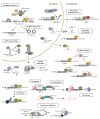RNA-Binding Proteins in Cancer: Functional and Therapeutic Perspectives
- PMID: 32967226
- PMCID: PMC7563379
- DOI: 10.3390/cancers12092699
RNA-Binding Proteins in Cancer: Functional and Therapeutic Perspectives
Abstract
RNA-binding proteins (RBPs) crucially regulate gene expression through post-transcriptional regulation, such as by modulating microRNA (miRNA) processing and the alternative splicing, alternative polyadenylation, subcellular localization, stability, and translation of RNAs. More than 1500 RBPs have been identified to date, and many of them are known to be deregulated in cancer. Alterations in the expression and localization of RBPs can influence the expression levels of oncogenes, tumor-suppressor genes, and genome stability-related genes. RBP-mediated gene regulation can lead to diverse cancer-related cellular phenotypes, such as proliferation, apoptosis, angiogenesis, senescence, and epithelial-mesenchymal transition (EMT)/invasion/metastasis. This regulation can also be associated with cancer prognosis. Thus, RBPs can be potential targets for the development of therapeutics for the cancer treatment. In this review, we describe the molecular functions of RBPs, their roles in cancer-related cellular phenotypes, and various approaches that may be used to target RBPs for cancer treatment.
Keywords: RNA-binding proteins (RBPs); cancer phenotype; cancer therapy; mechanistic function.
Conflict of interest statement
The authors declare no conflict of interest.
Figures


References
Publication types
Grants and funding
LinkOut - more resources
Full Text Sources

